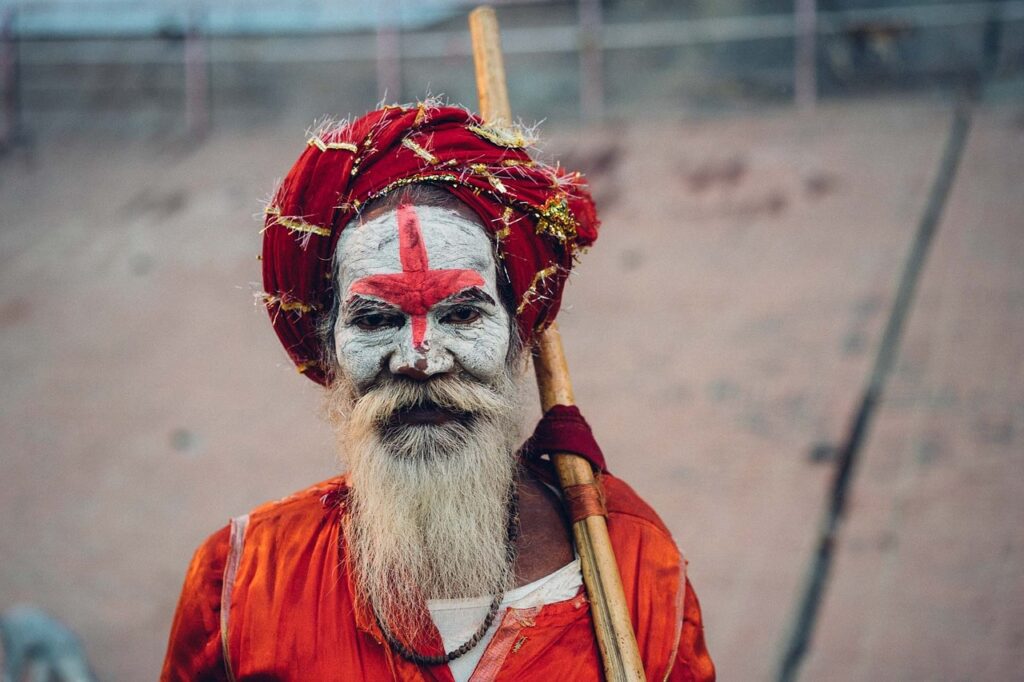Kumbh Mela, one of the largest religious gatherings in the world, is a grand confluence of faith, spirituality, and culture. This sacred event, celebrated by millions of devotees, is centered around the act of bathing in the holy rivers of India to cleanse the soul of sin and achieve liberation (moksha). Rooted in ancient Hindu tradition, the Kumbh Mela epitomizes the enduring power of spiritual belief and the sanctity of India’s rivers.
Origins and Significance of Kumbh Mela
The origins of Kumbh Mela are deeply embedded in Hindu mythology, specifically in the legend of the Samudra Manthan or the Churning of the Ocean of Milk. According to this tale, gods (Devas) and demons (Asuras) churned the ocean to obtain the nectar of immortality (amrita). As the churning progressed, various celestial objects emerged from the ocean, but the most sought-after was the pot (kumbh) containing the nectar. When the pot appeared, a fierce battle ensued between the Devas and Asuras over its possession.
As the demons and gods fought over the nectar, some drops of the elixir fell onto four places: Haridwar, Prayagraj (Allahabad), Nashik, and Ujjain. These places became sacred, and the Kumbh Mela evolved as an occasion to celebrate the divine presence at these locations, with devotees gathering to take a ritual bath in the holy rivers, which are believed to wash away sins and bring spiritual salvation.
To prevent the demons from seizing the nectar, Lord Vishnu disguised himself as Mohini, a celestial maiden, and carried the pot away. During his flight, four drops of nectar fell on four places on earth—Haridwar, Prayagraj (Allahabad), Ujjain, and Nashik. These cities, now revered as the sites of the Kumbh Mela, are believed to have absorbed the divine essence of the nectar, making them spiritually potent and sacred for bathing rituals.
The Kumbh Mela is one of the largest and most sacred religious gatherings in the world, attracting millions of pilgrims from across India and beyond. It is held at four locations—Allahabad (Prayagraj), Haridwar, Ujjain, and Nashik—on a rotating basis. The Kumbh Mela marks the convergence of divine and earthly energies, and its primary attraction is the opportunity to bathe in the holy waters of the Ganges, Yamuna, and other sacred rivers. In 2025, the Kumbh Mela promises to be a momentous occasion, drawing immense spiritual fervor and devotion from devotees who will seek to cleanse themselves of sins, purify their souls, and attain spiritual enlightenment.
The Kumbh Mela is not just a religious gathering; it is a profound expression of faith, culture, and the vastness of India’s spiritual heritage. It is a time when millions of people from all walks of life come together to seek divine blessings, renewal, and enlightenment. The mela transcends individual faith and becomes a collective experience of faith and spirituality.
Kumbh Mela 2025: What to Expect
The 2025 Kumbh Mela is set to be a grand event. It will be held in Prayagraj (formerly Allahabad), a city that has hosted the Kumbh Mela for centuries. Prayagraj is a significant spiritual center because it is where the Ganges and Yamuna rivers meet at the Triveni Sangam, a confluence that is regarded as one of the holiest spots in Hinduism. For Hindus, a bath at the Sangam during the Kumbh Mela is believed to wash away accumulated sins and lead to moksha, liberation from the cycle of birth and rebirth.
Preparations for the Kumbh Mela 2025 are already underway, with the government and various religious organizations working together to ensure the smooth functioning of the event. The city of Prayagraj will undergo significant infrastructure development to accommodate the millions of pilgrims expected to attend. Temporary camps, roads, bridges, sanitation facilities, and medical services will be set up to handle the massive influx of people, ensuring that safety, security, and basic amenities are available to all.
The 2025 Kumbh Mela will be unique in several ways, notably with regard to its scale and technological advancements. With the use of modern communication tools and technology, it will be easier for devotees to navigate the event, locate specific bathing spots, and find information about the schedule of religious ceremonies and events. The mela is also expected to feature spiritual discourses, cultural performances, and traditional rituals, creating an atmosphere that celebrates the rich diversity of Indian spirituality.
The Kumbh Mela Cycle
The Kumbh Mela is celebrated every 12 years at each of the four designated locations, rotating based on planetary alignments and astrological calculations. The specific timing of the festival is determined by the positions of Jupiter, the Sun, and the Moon.
There are four types of Kumbh Mela:
- Purna Kumbh Mela – Held every 12 years at one of the four sites.
- Ardh Kumbh Mela – Celebrated every 6 years, alternating between Haridwar and Prayagraj.
- Maha Kumbh Mela – Occurs every 144 years at Prayagraj and is considered the most significant.
- Magh Mela – An annual event held at Prayagraj during the Hindu month of Magha (January-February).
Each site hosts the Kumbh Mela according to its own astrological schedule, making the event a rare and precious occurrence in the spiritual life of devotees.
Holy Rivers and Their Spiritual Importance
Bathing in the holy waters during Kumbh Mela is the primary ritual. Each of the four sites is associated with a specific river, believed to possess unique spiritual benefits:
- Haridwar – The Ganges (Ganga)
The Ganges, considered the holiest river in Hinduism, flows through Haridwar. Bathing in the Ganga during Kumbh Mela is believed to purify one’s sins and bring spiritual liberation. Haridwar’s significance is heightened by its mention in ancient texts as a gateway to heaven. - Prayagraj (Allahabad) – Confluence of Ganga, Yamuna, and the Mythical Saraswati
Known as the Triveni Sangam, the confluence of these three rivers is considered one of the most sacred places in India. Bathing here during Kumbh Mela is thought to offer the highest spiritual merit, as it represents the merging of three divine forces. - Ujjain – The Shipra River
The Shipra River holds immense spiritual significance, particularly in relation to Lord Shiva. According to legend, a drop of nectar fell into this river, making it a site of great sanctity. Devotees believe that a dip in the Shipra during Kumbh Mela can bestow prosperity and salvation. - Nashik – The Godavari River
The Godavari, often called the Ganges of the South, is considered sacred for its ability to purify the soul. The Kumbh Mela in Nashik is associated with the legend of Lord Rama, who is said to have lived along its banks during his exile.
Rituals and Practices
The central ritual of Kumbh Mela is the Shahi Snan or royal bath, which marks the beginning of the festival. On specific auspicious days, large processions of ascetics, saints, and religious leaders, representing various Hindu monastic orders or Akharas, lead the bathing rituals. The Shahi Snan is considered the most sacred act of Kumbh Mela, symbolizing the cleansing of the soul.
Other important rituals include:
- Daily Bathing: Devotees take a dip in the holy waters at dawn, believing it washes away sins and paves the path to salvation.
- Prayers and Offerings: Devotees perform prayers, offer flowers, and light lamps as acts of devotion.
- Spiritual Discourses and Kirtans: Religious leaders and scholars deliver discourses on spiritual topics, and devotional songs (kirtans) are sung throughout the event.
- Meditation and Yoga: Many pilgrims engage in meditation and yoga to deepen their spiritual experience.
Akhara Processions and Naga Sadhus
A significant aspect of Kumbh Mela is the participation of various Akhara (monastic orders). The Akharas, which date back centuries, are groups of ascetics and saints who follow specific religious disciplines. The Naga Sadhus, known for their austere lifestyle and complete renunciation of material possessions, are a major attraction. These ash-covered ascetics, often clad in nothing but loincloths, lead the processions with great fanfare and reverence.
Cultural Significance
Beyond its religious aspect, Kumbh Mela is a vibrant cultural phenomenon. It is a melting pot of traditions, philosophies, and practices that reflect India’s rich spiritual heritage. The festival provides a platform for pilgrims from diverse backgrounds to come together, share their faith, and strengthen their spiritual resolve.
Art, music, and literature thrive during the event, with numerous stalls showcasing religious books, handicrafts, and devotional music. The Kumbh Mela also serves as a hub for exchanging ideas and knowledge, fostering interfaith dialogue and unity.
Global Recognition
The scale and significance of Kumbh Mela have garnered global attention, with millions of pilgrims and tourists attending from around the world. In 2017, UNESCO recognized Kumbh Mela as an Intangible Cultural Heritage of Humanity, highlighting its role in fostering a sense of community, spirituality, and cultural continuity.
Logistical and Environmental Challenges
Organizing Kumbh Mela, given its massive scale, is a colossal task. Authorities ensure the provision of essential services such as water, sanitation, food, and medical aid. Despite the challenges, modern technological advancements and meticulous planning have made it possible to manage the event efficiently.
However, the environmental impact of such a large gathering cannot be overlooked. Efforts are made to protect the rivers and minimize pollution through initiatives such as waste management and eco-friendly practices.
Kumbh Mela is more than just a religious gathering—it is a celebration of faith, a spiritual pilgrimage, and a testament to the enduring cultural and religious ethos of India. The sacred waters of the Ganga, Yamuna, Shipra, and Godavari embody the divine, offering millions of devotees a chance to seek redemption, inner peace, and eternal bliss. The festival, with its timeless rituals and profound significance, continues to inspire awe and reverence, drawing the faithful from all corners of the world to bathe in the holy waters and immerse themselves in the spiritual essence of life.



